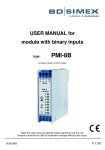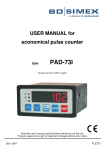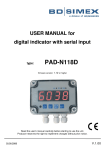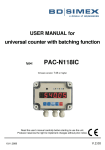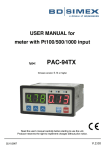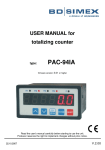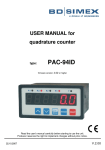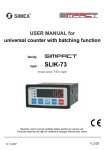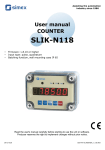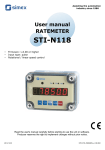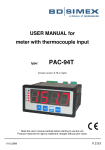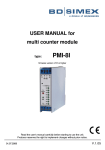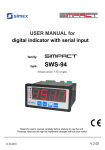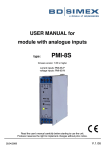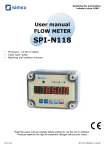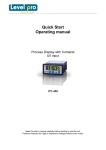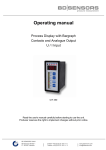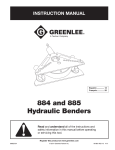Download English - BD Simex
Transcript
USER MANUAL for
pulse counter
type:
PAC-94IB
firmware version: 3.01 or higher
Read the user's manual carefully before starting to use the unit.
Producer reserves the right to implement changes without prior notice.
22.10.2007
V.2.00
User manual for pulse counter PAC-94IB
CONTENTS
1. BASIC REQUIREMENTS AND USER SAFETY ....................................................................................... 3
2. GENERAL CHARACTERISTICS.............................................................................................................. 4
3. TECHNICAL DATA .................................................................................................................................. 4
4. DEVICE INSTALLATION ......................................................................................................................... 6
4.1. UNPACKING .................................................................................................................................. 6
4.2. ASSEMBLY .................................................................................................................................... 6
4.3. CONNECTION METHOD ............................................................................................................... 8
4.4. MAINTENANCE ........................................................................................................................... 13
5. FRONT PANEL DESCRIPTION .............................................................................................................. 13
6. PRINCIPLE OF OPERATION ................................................................................................................. 14
6.1. MEASUREMENT MODE .............................................................................................................. 14
6.2. BATCHER FUNCTION ................................................................................................................. 15
6.3. THE DIGITAL FILTER .................................................................................................................. 17
6.4. CONTROL OF THE RELAY OUTPUTS (BATCHER MODE) ........................................................ 18
6.4.1. Driving of the relays during upcounting ............................................................................... 18
6.4.2. Driving of the relays during downcounting ........................................................................... 21
6.5. CONTROL OF THE RELAY OUTPUTS (STANDARD MODE)...................................................... 22
7. DEVICE PROGRAMMING ...................................................................................................................... 23
7.1. PROGRAMMING MENU .............................................................................................................. 23
7.2. PARAMETERS EDITION ............................................................................................................. 24
7.2.1. Numeric parameters ........................................................................................................... 24
7.2.2. Switch parameters (“LIST” type) ......................................................................................... 24
7.3. MENU DESCRIPTION ................................................................................................................. 24
7.3.1. “rL1”, “rL2” menu..................................................................................................................25
7.3.2. “rES” parameter .................................................................................................................. 26
7.3.3. “Ar” parameter .................................................................................................................... 26
7.3.4. “dLy” parameter .................................................................................................................. 26
7.3.5. “mod” parameter ................................................................................................................. 26
7.3.6. “dir” parameter .................................................................................................................... 26
7.3.7. “FiL” parameter ................................................................................................................... 27
7.3.8. “CAL” menu ........................................................................................................................ 27
7.3.9. “rS” menu ........................................................................................................................... 27
7.3.10. “Cod” parameter ............................................................................................................... 28
7.3.11. “dEF” parameter ............................................................................................................... 28
7.4. MENU STRUCTURE ................................................................................................................... 29
8. EXAMPLES OF PRESCALER PARAMETERS CALCULATION............................................................ 30
9. THE MODBUS PROTOCOL HANDLING ............................................................................................... 31
9.1. LIST OF REGISTERS .................................................................................................................. 31
9.2. TRANSMISSION ERRORS DESCRIPTION................................................................................. 33
9.3. EXAMPLES OF QUERY/ANSWER FRAMES .............................................................................. 33
10. DEFAULT AND USER'S SETTINGS LIST ............................................................................................37
2
User manual for pulse counter PAC-94IB
Explanation of symbols used in the manual:
- This symbol denotes especially important guidelines concerning the installation and
operation of the device. Not complying with the guidelines denoted by this symbol
may cause an accident, damage or equipment destruction.
IF THE DEVICE IS NOT USED ACCORDING TO THE MANUAL THE USER IS
RESPONSIBLE FOR POSSIBLE DAMAGES.
- This symbol denotes especially important characteristics of the unit. Read any
information regarding this symbol carefully
1. BASIC REQUIREMENTS AND USER SAFETY
- The manufacturer is not responsible for any damages caused by
inappropriate installation, not maintaining the proper technical condition and
using the unit against its destination.
- Installation should be conducted by qualified personnel. During installation all
available safety requirements should be considered. The fitter is responsible for
executing the installation according to this manual, local safety and EMC
regulations.
- The unit must be properly set-up, according to the application. Incorrect
configuration can cause defective operation, which can lead to unit damage or an
accident.
- If in the case of a defect of unit operation there is a risk of a serious threat to
the safety of people or property additional, independent systems and
solutions to prevent such a threat must be used.
- The unit uses dangerous voltage that can cause a lethal accident. The unit
must be switched off and disconnected from the power supply prior to
starting installation of troubleshooting (in the case of malfunction).
- Neighbouring and mating equipment must meet the requirements of appropriate
standards and regulations concerning safety and be equipped with adequate antiovervoltage and anti-interference filters.
- Do not attempt to disassemble, repair or modify the unit yourself. The unit
has no user serviceable parts. Units, in which a defect was stated must be
disconnected and submitted for repairs at an authorized service centre.
- In order to minimize fire or electric shock hazard, the unit must be protected
against atmospheric precipitation and excessive humidity.
- Do not use the unit in areas threatened with excessive shocks, vibrations, dust,
humidity, corrosive gasses and oils.
3
User manual for pulse counter PAC-94IB
- Do not use the unit in explosion hazard areas.
- Do not use the unit in areas with significant temperature variations, exposed to
condensation or icing.
- Do not use the unit in areas exposed to direct sunlight.
- Make sure that the ambient temperature (e.g. inside the control box) does not
exceed the recommended values. In such cases forced cooling of the unit must be
considered (e.g. by using a ventilator).
The unit is designed for operation in an industrial environment and must not
be used in a household environment or similar.
2. GENERAL CHARACTERISTICS
Counter type PAC-94IB is designed for up-down counting of pulses in 3 decades and has
single program register using for programming the batcher function. The programming of the
counter is realised by push-buttons, and direction of counting can be selected by user.
PAC-94IB is equipped with many modern features required in simple and advanced automatic
control systems. The counter is made for hard environment conditions, and with use of modern
materials and electronic components,
Located on front panel push-buttons allow manual setting of the device according to user
requirements. Build in RS-485 communication interface enables controlling of all settings by
host, and allows use of unit in advanced network systems. The counter is equipped with single
counting, hold, stop, clear/start inputs. PAC-94IB has two build in relays (N.O.) with selectable
thresholds and modes of operation. It can be used for controlling of external devices. The
counter is prepared for cooperation with NPN as well as PNP type sensors, Due to internal
digital denouncing filter simple contactors can be used as sensors. Additionally build in sensor
supply output (24 VDC) can be used to supply contactors and some types of electronic sensors.
All inputs are fully separated from external power supply, relays outputs, and communication
interface, and has single common terminal.
3. TECHNICAL DATA
Power supply voltage
(depending on version)
External fuse (required)
Power consumption
Pulse inputs
A input
B input
C input
D input
COM
4
85...230...260 VAC/DC; 50 ÷ 60 Hz
or 19...24...50 VDC; 16...24...35 VAC
T - type, max. 2 A
max. 4.5 VA @ 85 V ÷ 260 VAC/DC
max. 4.5 VA @ 16 V ÷ 35 VAC
max. 4.5 W @ 19 V ÷ 50 VDC
counting (terminal no. 16)
hold input (terminal no. 17)
stop (terminal no. 18)
clear/start (terminal no. 19)
common terminal (terminal no. 20)
User manual for pulse counter PAC-94IB
Input levels
low level:
high level:
Max. input frequency
0V÷1V
10 V ÷ 30 V
electronic: 10 kHz
contact: 90 Hz (adjustable filter)
Display range
result:
settings:
000 ÷ 999
000 ÷ 999
Outputs
relay:
or OC-type:
sensor power supply:
2 NO, 1 A / 250 VAC (cos ϕ = 1)
4 30 mA / 30 VDC / 100 mW
24 V +5 %, -10 % / max. 100 mA, stabilized
Communication interface
RS-485, 8N1 and 8N2, Modbus RTU, not separated
Baud rate
1200 bit/sec ÷ 115200 bit/sec
Display
result:
settings:
LED, 3 digit, 13mm height, red
LED, 3 digit, 13mm height, green
Data memory
non-volatile memory, EEPROM type
Protection level
IP 65 (from front, after using waterproof cover)
IP 40 (from front)
IP 20 (housing and connection clips)
Housing type
Housing material
Housing dimensions
Panel cutout
Assembly depth
Panel thickness
panel
NORYL - GFN2S E1
96 x 48 x 100 mm
90.5 x 43 mm
102 mm
max. 5 mm
Operating temperature
Storage temperature
Humidity
Altitude
0 °C to +50 °C
-10 °C to +70 °C
5 to 90 % no condensation
up to 2000 meters above sea level
Screws tightening max. torque
Max. connection leads diameter
0.5 Nm
2
2.5 mm
Safety requirements
according to: PN-EN 61010-1
installation category: II
pollution degree: 2
voltage in relation to ground: 300 VAC
insulation resistance: >20 MΩ
insulation strength between power supply and
input/output terminal: 1 min. @ 2300 V
insulation strength between relays terminal:
1 min. @ 1350 V
EMC
according to: PN-EN 61326
5
User manual for pulse counter PAC-94IB
This is a class A unit. In housing or a similar area it can cause radio frequency
interference. In such cases the user can be requested to use appropriate
preventive measures.
4. DEVICE INSTALLATION
The unit has been designed and manufactured in a way assuring a high level of user safety and
resistance to interference occurring in a typical industrial environment. In order to take full
advantage of these characteristics installation of the unit must be conducted correctly and
according to the local regulations.
- Read the basic safety requirements on page 3 prior to starting the installation.
- Ensure that the power supply network voltage corresponds to the nominal voltage
stated on the unit’s identification label.
- The load must correspond to the requirements listed in the technical data.
- All installation works must be conducted with a disconnected power supply.
- Protecting the power supply clamps against unauthorized persons must be taken
into consideration.
4.1. UNPACKING
After removing the unit from the protective packaging, check for transportation damage. Any
transportation damage must be immediately reported to the carrier. Also, write down the unit
serial number on the housing and report the damage to the manufacturer.
Attached with the unit please find:
- user’s manual
- warranty
- assembly brackets - 2 pieces
4.2. ASSEMBLY
- The unit is designed for mounting indoor inside housings (control panel,
switchboard) assuring appropriate protection against electric impulse waves. Metal
housing must be connected to the grounding in a way complying with the governing
regulations.
- Disconnect the power supply prior to starting assembly.
- Check the correctness of the performed connections prior to switching the unit on.
In order to assembly the unit, a 90.5 x 43 mm mounting hole (Figure 4.1) must be
prepared. The thickness of the material of which the panel is made must not exceed
5 mm. When preparing the mounting hole take the grooves for catches located on
both sides of the housing into consideration (Figure 4.1). Place the unit in the
mounting hole inserting it from the front side of the panel, and then fix it using the
brackets (Figure 4.2). The minimum distances between assembly holes’ axes - due
to the thermal and mechanical conditions of operation - are 115 mm x 67 mm
(Figure 4.3).
6
User manual for pulse counter PAC-94IB
Figure 4.1. Mounting hole dimensions
Figure 4.2. Installing of brackets, and dimensions of connectors.
7
User manual for pulse counter PAC-94IB
Figure 4.3. Minimum distances when assembly of a number of units
4.3. CONNECTION METHOD
Caution
- Installation should be conducted by qualified personnel. During installation all
available safety requirements should be considered. The fitter is responsible for
executing the installation according to this manual, local safety and EMC
regulations.
- The unit is not equipped with an internal fuse or power supply circuit breaker.
Because of this an external time-delay cut-out fuse with minimal possible nominal
current value must be used (recommended bipolar, max. 2 A) and a power supply
circuit-breaker located near the unit. In the case of using a monopolar fuse it must
be mounted on the phase cable (L).
- The power supply network cable diameter must be selected in such a way that in
the case of a short circuit of the cable from the side of the unit the cable shall be
protected against destruction with an electrical installation fuse.
- Wiring must meet appropriate standards and local regulations and laws.
- In order to secure against accidental short circuit the connection cables must be
terminated with appropriate insulated cable tips.
- Tighten the clamping screws. The recommended tightening torque is 0.5 Nm.
Loose screws can cause fire or defective operation. Over tightening can lead to
damaging the connections inside the units and breaking the thread.
- In the case of the unit being fitted with separable clamps they should be inserted
into appropriate connectors in the unit, even if they are not used for any
connections.
- Unused clamps (marked as n.c.) must not be used for connecting any
connecting cables (e.g. as bridges), because this can cause damage to the
equipment or electric shock.
8
User manual for pulse counter PAC-94IB
- If the unit is equipped with housing, covers and sealing packing, protecting
against water intrusion, pay special attention to their correct tightening or clamping.
In the case of any doubt consider using additional preventive measures (covers,
roofing, seals, etc.). Carelessly executed assembly can increase the risk of electric
shock.
- After the installation is completed do not touch the unit’s connections when it is
switched on, because it carries the risk of electrical shock.
Due to possible significant interference in industrial installations appropriate measures
assuring correct operation of the unit must be applied. To avoid the unit of improper
indications keep recommendations listed below.
-
Avoid common (parallel) leading of signal cables and transmission cables together
with power supply cables and cables controlling induction loads (e.g. contactors).
Such cables should cross at a right angle.
-
Contactor coils and induction loads should be equipped with anti-interference
protection systems, e.g. RC-type.
-
Use of screened signal cables is recommended. Signal cable screens should
be connected to the earthing only at one of the ends of the screened cable.
-
In the case of magnetically induced interference the use of twisted couples of signal
cables (so-called “spirals”) is recommended. The spiral (best if shielded) must be
used with RS-485 serial transmission connections.
-
In the case of interference from the power supply side the use of appropriate antiinterference filters is recommended. Bear in mind that the connection between the
filter and the unit should be as short as possible and the metal housing of the filter
must be connected to the earthing with largest possible surface. The cables
connected to the filter output must not run in parallel with cables with interference
(e.g. circuits controlling relays or contactors).
Connections of power supply voltage and measurement signals are executed using the screw
connections on the back of the unit’s housing
Figure 4.4. Method of cable insulation replacing and cable terminals
All connections must be made while power supply is disconnected!
9
User manual for pulse counter PAC-94IB
Figure 4.5. Terminals description (relay outputs)
Description of control signals' symbols.
{ A }, { B }
{C}
{D}
{ COM }
- counting input, pulse
- programmable input
- reset counter input
- common terminal
Figure 4.6. Terminals description (OC-type outputs)
10
User manual for pulse counter PAC-94IB
Depending on version:
85…230…260 VAC/DC or
19…24…50 VDC; 16…24…35 VAC
Figure 4.7. Connection of power supply and relays
Contacts of relay outputs are not equipped with spark suppressors. While use
the relay outputs for switching of inductive loads (coils, contactors, power
relays, electromagnets, motors etc.) it is required to use additional suppression
circuit (typically capacitor 47 nF/ min. 250 VAC in series with 100R/5 W resistor),
connected in parallel to relay terminals or (better) directly on the load. In
consequence of using the suppression circuit, the level of generated
electromagnetic disturbances is lower, and the life of relay contacts rises.
Figure 4.8. Examples of suppression circuit connection:
a) to relay terminals; b) to the inductive load
11
User manual for pulse counter PAC-94IB
Figure 4.9. Example of OC-type outputs connection
Construction of counter's inputs allows connecting of pulser with common earth (Figure 6.1 a) or
common plus (Figure 6.1 b), without additional intermediary circuits (sensor with NPN or PNP
type output); for outputs of push-pull type kind of connection has no matter.
Figure 4.10. An example of pulser connection:
a) with common earth, b) with common plus
12
User manual for pulse counter PAC-94IB
4.4. MAINTENANCE
The unit does not have any internal replaceable or adjustable components available to the user.
Pay attention to the ambient temperature in the room where the unit is operating. Excessively
high temperatures cause faster ageing of the internal components and shorten the fault-free
time of unit operation.
In cases where the unit gets dirty do not clean with solvents. For cleaning use warm water with
small amount of detergent or in the case of more significant contamination ethyl or isopropyl
alcohol.
Using any other agents can cause permanent damage to the housing.
Product marked with this symbol should not be placed in municipal waste. Please
check local regulations for disposal and electronic products.
5. FRONT PANEL DESCRIPTION
Symbols and functions of push-buttons:
Symbol used in the manual: [ENTER/MENU]
Functions:
•
in measurement mode: Enter to main menu (press and hold by at least 2 sec.)
•
in Menu mode: Start to edit the parameter or confirmation of changes made in
parameter being edited
Symbol used in the manual: [^]
Functions:
•
in measurement mode: edition of adjuster value
•
in Menu mode: Change of the present menu or Modification of the parameter
value
Symbol used in the manual: [ESC/RESET]
Functions:
•
in measurement mode: initializes new cycle (see MEASUREMENT MODE and
MENU DESCRIPTION)
•
in Menu mode: Exit the current level and Enter to previous menu (or measure
mode), Cancel the changes made in parameter being edited
13
User manual for pulse counter PAC-94IB
6. PRINCIPLE OF OPERATION
After turning the power supply on, device ID and software version are showed on the display,
next the data stored while power supply off are restored and device goes to the selected
operation mode.
6.1. MEASUREMENT MODE
During normal operation the counter counts pulses from input { A }, divides its quantity by “div”
parameter, and shows the result on right LED display (red) with selected decimal point position
(parameter “Pnt”). Displayed values are contained in 3 decades (000 ÷ 999). While its value
exceeds 3 decades, its value turns on itself (it counts like this: 998, 999, 000, 001 or 001, 000,
999, 998 – depends on counting direction). Left LED display (green) is called adjuster, and
shows current value of parameter “Pr1”.
PAC-94IB counter can be programmed to any value form range 1 ÷ 1000. Value 1000 can be
obtained setting 000. In such case driving of relays is realised after counting of 1000 units (it can
be more pulses depend on “div”). To change particular position of programmed value use [^]
buttons. To simplify entering of the thresholds decimal point on both displays is showed on the
same positions.
Device counts pulses UP as well as DOWN. The selection of counting direction is realised using
programming menu.
The initialisation of counting cycle (e.g. batching) can be made in several ways:
•
pushing [ESC/RESET] button
•
delivering of active state to external clear/start input { D }
•
direct storing of internal registers via RS-485 interface
When initialization of counting cycle occurs, following operations are realised by internal
software: clearing of counter register (while counting UP) or loading of counter register with
value equal to adjuster value showed on left (green) LED display. Next the device starts counting
in selected direction, and LED marked “F” lights until end of counting cycle.
Together with initialization of counting cycle new relays controlling cycle starts. (see chapter:
CONTROL OF THE RELAY OUTPUTS...).
Depending on parameter “Ar” (see description: “Ar” parameter) counting and controlling cycles
are realised once or sequentially, allowing automatic controlling of process without user
interaction. Counting cycle ends (LED “F” dims) after counter reach stored threshold. For
counting UP this is value stored while initialisation of the cycle, for counting DOWN it is zero.
Delivering of active state to control inputs “hold” (marked { B }) causes holding of counting.
Active state on input { B } causes holding of counting, but has no influence to
realisation of counting and relays controlling cycles.
Delivering of active state to stop input marked { C } causes termination of counting relays
controlling cycles. Relays are driven to its inactive state (see description of parameters “mr1”
and “mr2” of “rL1”, “rL2” menu).
14
User manual for pulse counter PAC-94IB
The change of adjuster value during realisation of counting cycle do not change the
threshold stored while initialisation of the cycle. Storing of the new value is done while
initialisation of the new cycle (automatic or manual).
If AUTORESET function is active (parameter “Ar” = “on”), next cycle starts automatically with
delay “dLy” (see description of parameter “dLy”) after counter reach previously stored threshold
of relay R1 (“Pr1” or “000”, depend on selected direction). During delay device counts pulses,
and LED “F” flashes signalling realisation of delay. If AUTORESET function is inactive, next cycle
must be initialised by user using [ESC/RESET] button, by control input clear/start marked { D },
or by writing of internal registers via RS-485 interface.
While power off, device stores its current counter value and restores it it after power
on. The state of counting and relays controlling cycles is not restored, it must be
initialised manually after power on (even if AUTORESET is active).
All accessible parameters can be changed by entering the menu (see: DEVICE
PROGRAMMING). Use the local keyboard or the remote controller to do it. (Note: all parameters
can be remote changed via RS-485 interface).
Counting and relays controlling are independent of operation mode of the counter.
They are continued (in background) even in menu mode.
6.2. BATCHER FUNCTION
To set PAC-94IB for operate as a batcher it must be connected in proper way with valves and
flow sensor, additionally parameter “mod” must be set to “bAt” value (see description of
”mod” parameter). Producer assumes that two valves will be used (main valve with bigger
diameter controlled by relay R2, and additional valve with small diameter – controlled by relay
R1). In this mode value showed on adjuster display (left, green display) is equal to threshold of
relay R1 (Pr1), it means required volume of medium, and parameter Pr2 is handled as constant
control advance (defined from Menu level) of the process.
Depending on counting direction there are possible two methods of batcher operation. First
method (while “dir” = “UP”), the counter counts UP and shows current volume of medium. After
pressing of RESET button (and confirmation), counter is zeroed and both relays are activated
(e.g. both valves opened) - the batching process is in progress. In this mode relay R2 controls
main valve will be deactivated when counter reaches value Pr1 – Pr2, (parameter Pr2 is used as
control advance). If Pr2 > Pr1, then Relay R2 is not activated after reset (initialisation of new
cycle). Relay R1 will be deactivated when counter reach value stored during the initialisation
(desired volume). The process can be repeated (with old or new value of Pr1 - if changed, even
while realisation of previous cycle) after pressing of RESET button, or (if AUTORESET is active)
automatically after delay defined by parameter “dLy” (0 to 99.9 sec) since counter reached
previous Pr1 threshold.
If parameter “dir” = “dn”, then counter counts down and shows how much of medium left to end
of the cycle. With such settings after pressing of RESET button (and confirmation) counter will
be loaded with value showed on adjuster (Left, green LED display) equal to current Pr1
threshold, and both relays will be activated - batching process is in progress. Relay R2 controls
main valve, and will be deactivated when counter reaches value lower than parameter Pr2, (Pr2
is used as control advance). If Pr2 > Pr1 then relay R2 would be not activated after reset. Relay
R1 will be deactivated when counter reach 0 (counting DOWN).
15
User manual for pulse counter PAC-94IB
Similar like in first case the process can be repeated after next press of RESET button, and (if
AUTORESET is active) it will be done automatically after delay defined by parameter “dLy”,
since counter reached 0.
“Dir” parameter
State of the counter
after RESET (value)
Deactivation of R1
when counter reaches
Deactivation of R2
when counter reaches
UP
0
Pr1
Pr1-Pr2
dn
Pr1
0
Pr2-1
Tab. 6.1. Table of batcher mode operation
Proposed in example system is showed in Figure 6.1, and proposed circuit diagram in Figure 6.2.
More details of this example are described on page 30 in example no. 3.
Figure 6.1. Proposed system
16
User manual for pulse counter PAC-94IB
Figure 6.2. Proposed circuit diagram
6.3. THE DIGITAL FILTER
To enable the connection of the simple switches as detectors, special digital filter has been build
into the device. This filter allows the counter to proper counting pulses regardless of the vibration
of the contacts of the switches.
The condition of proper counting is providing of time periods of the pulses. The filter can be set to
blocking frequencies higher than 10, 20, 30, 40, 50, 60, 70, 80 and 90 Hz. The time periods of
stable states “0” (t0) and “1” (t1) of pulses must be not shorter than ½ F, where F the filtered
frequency in Hz. See the table below (Tab. 6.2) to check proper periods for all frequencies.
filter setting (F)
t0 , t1
Input signal
frequency
OFF
50.0 µs
10 kHz
10
50.0 ms
10 Hz
20
25.0 ms
20 Hz
30
16.7 ms
30 Hz
electronic
40
12.5 ms
40 Hz
or contact
Input type
electronic
input
17
User manual for pulse counter PAC-94IB
filter setting (F)
t0 , t1
Input signal
frequency
50
10.0 ms
50 Hz
60
8.3 ms
60 Hz
70
7.2 ms
70 Hz
80
6.3 ms
80 Hz
90
5.6 ms
90 Hz
Input type
input
Tab. 6.2. Time periods t0, t1 depend on filtered frequency.
When the filter is turned off, time periods t0 i t1 must be longer than 50 ms (see Figure 6.3), and
maximum counted frequency is equal 10 kHz.
Figure 6.3. The traces of signals:
a) without contacts oscillations, b) with contacts oscillations
6.4. CONTROL OF THE RELAY OUTPUTS (BATCHER MODE)
Controlling of external devices due to state of the counter is realised using relay outputs.
Operation of relay output is described by parameters: “dir”, “Pr1”, “Pr2”, “tr1”, “tr2”, “mr1”,
“mr2”, “dLy” and “Ar”.
6.4.1. Driving of the relays during upcounting
The mode of relays operation during upcounting (parameter “dir” = “UP”) for example settings
is showed in figure 6.4 (AUTORESET function is inactive) and in figure 6.5 (active AUTORESET
function).
18
User manual for pulse counter PAC-94IB
After initialisation if counting cycle (point S, plot: a) all relay outputs are set to its active state.
During controlling cycle relays outputs can change its state to inactive, only after counter reach
stored threshold value (“Pr1” for relay R1 and (“Pr1” - “Pr2”) for relay R2; points A, B, D, E in
Figure 6.4a, Figure 6.5a).
Description:
S
A, B, D, E
C, F
tX1, tX2
tZ
- initialisation of the counting cycle
- points while counter exceeds selected value
- manual initialisation of counting cycle
- idle time (device is waiting for manual initialisation)
- delay of relay reaction
Figure 6.4 Example of relay outputs
driving during upcounting (parameter “Ar”=“oFF”)
Active state of the relays (on or off) is defined by parameters “mr1”, “mr2”. The reaction of the
counter when it reaches threshold value is immediate. Parameters “tr1” and “tr2” defines how
long the relay should stay inactive after the moment when counter reached the threshold value.
●
If parameter “tr1” or “tr2” is set to “0” then related relay stay inactive, until next
initialisation of counting cycle (manual: points C, F in Figure 6.4a, b, c or automatic: point C
in Figure 6.5a, b, c).
19
User manual for pulse counter PAC-94IB
Description:
S
- initialisation of the counting cycle
A, B
- points while counter exceeds selected value
C
- automatic initialisation of counting cycle
Figure 6.5 Example of relay outputs driving
during upcounting (parameter “Ar”=“on”)
●
If parameter “tr1” or “tr2” is set to value greater than “0” then related relay stay inactive
during time defined by this parameter (Figure 6.4a, d, e), but no longer than to next manual
initialisation of counting cycle (points C, F in Figure 6.4a, d, e). In case when AUTORESET
function is active, particular relay stay inactive during time defined by parameters “tr1” or
“tr2” (Figure 6.5a, d, e) regardless of automatic initialisation of new cycle.
If AUTORESET is active, then it is possible to add additional delay of automatic initialisation of
next cycle (Figure 6.5a) by proper setting of parameter “dLy”.
When parameters “dLy”=“0”, “tr1”=“0” and “tr2”=“0” and AUTORESET function
is 1 active, relay R1 will not change its state to inactive. If in addition, time between
exceeding of relays R2 and R1 thresholds is shorter than relay reaction delay (tZ),
then R2 will not change its state to inactive.
20
User manual for pulse counter PAC-94IB
Parameters “mr1”, “mr2” can be set to value “mb”, allow controlling of the relays via serial
interface. In this case states of relays are completely independent on counter state and its other
settings. Change of their state is realised exclusively by writing of their related registers via
RS-485 interface (see LIST OF REGISTERS). If parameter “mr1” or “mr2” is set to “on” or
“oFF”, writing of those registers has no effect, and reading gets current state of the registers.
If mode “mb” is active, then after power up particular relay is open. In other modes
(“on” or “oFF”) relay will be in its inactive state.
While power down device is storing its counter state, and restores it after power up. The state of
cycle realisation is not stored, and after power up it must be initialised by user.
All parameters corresponding to relay outputs are described in details in chapter MENU
DESCRIPTION.
6.4.2. Driving of the relays during downcounting
The mode of relays operation while downcounting (parameter “dir” = “dn”), with example
settings is showed in figure 6.6.
The principle of relays driving is the same as for upcounting, but different are starting value
(while initialisation) and relays thresholds. Starting value for counting cycle is the value of
parameter “Pr1” (Figure 6.6a), equal to adjuster (left, green LED display). The threshold of R1
relay is “000”, and the threshold of relay R2 is “Pr2” (points: A, B, D in Figure 6.6).
Description:
S
- initialisation of the counting cycle
A, B, D
- points while counter exceeds selected value
C
- automatic initialisation of counting cycle
Figure 6.6 Example of relay outputs driving
during downcounting (parameter “Ar”=“oFF”)
21
User manual for pulse counter PAC-94IB
6.5. CONTROL OF THE RELAY OUTPUTS (STANDARD MODE)
In standard mode, only relay R1 is controlled by counter. The principle of control is the same as
in batcher mode, so read carefully chapter 6.4. The only difference in controlling of the relay is
the interpretation of parameters “tr1” and “mr1”.
In standard mode, after initialisation of counting cycle (point S, Figure 6.7a) relay output is driven
to inactive. During control cycle relay outputs can change its state to active only when the
counter reach threshold value (“Pr1” while upcounting, and “000” while downcounting).
Parameter “tr1” defines time during which relay R1 stays active after counter reach threshold
value.
Description:
S
A, B, D, E
C, F
tX1, tX2
tZ
- initialisation of the counting cycle
- points while counter exceeds selected threshold value
- manual initialisation of counting cycle
- idle time (device is waiting for manual initialisation)
- delay of relay reaction
Figure 6.7 Principle of relay outputs operation (parameter “Ar”=“oFF”)
In standard mode it is possible to set automatic initialisation of the cycle. (parameter “Ar”=“on”)
with additional delay (parameter “dLy” >0).
All parameters corresponding to relay outputs are described in details in chapter MENU
DESCRIPTION.
22
User manual for pulse counter PAC-94IB
7. DEVICE PROGRAMMING
The Menu allows to set all parameters of the device (among others, controlling of relays, source
of the cycle initialisation, method of results displaying, access settings). The meaning of
parameters is described in chapter MENU DESCRIPTION.
Selected parameters are available without entering the menu. To change value of particular
decades use [^] buttons, located under left display. To simplify reading of adjuster decimal point
on both displays is showed on the same position
The change of the adjuster value while realisation of current cycle, has no influence
to stored threshold – the new value is being stored while next initialisation of the
cycle (manual or automatic).
7.1. PROGRAMMING MENU
To enter main menu (being in the measurement mode) operator must to press and hold at least
2 sec. [ESC/MENU] button.
If the user password is defined (see parameter “Cod“), operator have to enter correct one before
proceeding to menu options. Entering of the passwords is being made by changing of particular
digits by [^] buttons, and accepting of password by [ENTER/MENU] button.
After entering of last digit of the password first menu position will be displayed (if the password is
correct) or warning “Err” in other case.
Pay attention when device parameters are being changed. If it is possible, turn off
controlled installation (machine).
Functions of the buttons while sub-menu and parameters choice:
Buttons signed [^] are used to change value of particular digit (digit above
particular button) and change of current menu position. The name of selected
option is displayed on the left (green) display. The right (red) display shows current
menu name or is dimmed.
Operation of [ENTER/MENU] button depend on present menu position:
•
if the name of some sub-menu is displayed - enter this sub-menu; name of the
first parameter (or next level sub-menu) is displayed,
•
if the name of some parameter is displayed - enter the edition of this
parameter; present value of the parameter is displayed,
After pressing of [ENTER/MENU] button, name of current menu is scrolled from
the left to the right display, and on the left display name of submenu or current
value of selected parameter is displayed.
After about 1 min. since last use of the buttons, device exits the menu mode and
returns to the measurement mode (only if no parameters are in editing mode).
After about 1 min. since last use of the buttons, device exits the menu mode and
returns to the measurement mode (only if no parameters are in editing mode).
23
User manual for pulse counter PAC-94IB
7.2. PARAMETERS EDITION
To start edition of any parameter user should select name of desired one using [^] buttons and
then [ENTER/MENU].
Presently edited numerical value, or list-type value flashes on the left (green) display. The right
(red) display shows the name of edited parameter at the same time.
7.2.1. Numeric parameters
Numeric parameters constitute a series of digits that form a number in decimal format. Entering a
new parameter value consists of changing the values of selected digits within the allowable
range (using the [^] keys).
7.2.2. Switch parameters (“LIST” type)
Switch parameters can be described as a sets of values (a lists) out of which only one of the
options available on the list can be selected for the given parameter. Options of switching
parameter are selected using [^] keys.
Functions of buttons when editing numeric and switching parameters:
Change of digit value referred to particular [^] key (numerical values e.g.:
parameter “Adr”) or state of list-type parameters (e.g.: parameter “bAu”).
Press of [ENTER/MENU] button causes of display a “SEt ?” ask, which allow user
to make sure if change of the parameter value is correct. When [ENTER/MENU]
button is pressed again (while “SEt ?” is displayed) the new value of the
parameter is stored in EEPROM memory. Next, present parameter value is
displayed and edition stops.
Pressing this button operator can cancel the changes done up to now (if they were
not approved by [ENTER/MENU] button after the “SEt ?” ask), and device come
back to menu.
7.3. MENU DESCRIPTION
“- - - - Cod”
Password checking. If password is set different from “000”, than every enter to
main menu follows the entering of password. If entered password is correct
first menu position else warning “Err” will be displayed, and unit returns to
measurement mode.
Due to problem with direct displaying of “m” letter, it is exchanged with special signs
“ “. Independently in user manual letters “m” is used to make it more readable
(example: “modE”).
24
User manual for pulse counter PAC-94IB
7.3.1. “rL1”, “rL2” menu
This menu contains options of configuration of operation of relay R1 and R2. Principle of the
relay operation is described in paragraph CONTROL OF THE RELAY OUTPUTS....
“Pr1”, “Pr2”
- selection of relays thresholds (range 0 ÷ 999).
a) in standard mode (“mod” = “Std”)
For upcounting relay R1 is driven to active state when counter reaches
value “Pr1”, and for downcounting when counter reaches “000”. Relay
R2 is unavailable in standard mode
b) in batcher mode (“mod” = “bAt”)
While upcounting relay R1 is driven to its inactive state after exceeding
of “Pr1” value, and relay R2 after exceeding of value (“Pr1” – “Pr2”).
For downcounting relay R1 is driven to its inactive state after counter
reaches value “000”, and relay R2 when counter reaches value “Pr2”.
“tr1”, “tr2”
- In standard mode (“mod” = “Std”) this is time while relays stay in their
inactive states, in batcher mode (“mod” = “bAt”) this is time while
relays stay in their active state.
Available range: “0.0” ÷ “99.9” express time in seconds.
Selection of “0.0” causes holding relays in their states (inactive and
active respectively depending on mode) until next initialisation of the
cycle.
“mr1”, “mr2”
- method of relays operation. This parameters defines active state of
the relays. In standard mode (“mod” = “Std”) active state means the
state of the relay set after counter reaches selected threshold. In
batcher mode (“mod” = “bAt”) active state of the relay is set directly
after initialisation of the cycle.
There available 3 possibilities:
“on”
“oFF”
“mb”
- relay is closed in active state
- relay is open in active state
- relay is driven via serial RS-485 interface, independently of counter
state parameters “Pr1”, “Pr2”, “tr1” and “tr2”.
●
●
When contacts of relay are closed, particular LED lights
If “mb” mode is active then after power up particular relay is open, in other modes (“on”and
“oFF”) relay will be set to its inactive state.
25
User manual for pulse counter PAC-94IB
7.3.2. “rES” parameter
This parameter determines the counter zeroing (reset) sources, and can be set to one of the
values:
“ALL”
- this option enables both manual (using [ESC/RESET] button) and electronic
reset.
“mAn”
- enables manual initialisation of the cycle using button [ESC/RESET] on the
counter front panel. This operation requires confirmation by [ENTER] button.
“EL”
- allows activation of additional control input { D }. Delivering of active state to
this input causes initialisation of the cycle. Active state on this input must stay
at least 10 ms. In this mode clearing by [ESC/RESET] button is unavailable;
“no”
- this option disables both manual and electronic reset.
It is possible to clear the counter via RS-485 interface, by writing value 000h to some
registers. This method of clearing is available regardless of selected value of
parameter “rES”.
7.3.3. “Ar” parameter
This parameter enables AUTORESET, and allows automatic initialisation of next cycle, loading
the starting value to the counter (“000” or “Pr1” depending on counting direction).
Available settings:
“on”
“oFF”
- AUTORESET function is active,
- AUTORESET function is inactive.
7.3.4. “dLy” parameter
This parameter allows to add some delay after moment when counter reach threshold value to
automatic initialisation of the next cycle while AUTORESET function is active (AUTORESET =
“on”). Parameter is expressed in seconds and can be set in range “0.0” to “99.9”. Detailed
description of relays operation principle is showed in chapter CONTROL OF THE RELAY
OUTPUTS....
7.3.5. “mod” parameter
This parameter defines device principle of operation:
“Std”
- the device operates as standard counter, only R1 relay is controlled,
“bAt”
- the device operates as a batcher, both relays are controlled
Principle of the relay operation is described in paragraph CONTROL OF THE RELAY
OUTPUTS....
7.3.6. “dir” parameter
This parameter defines direction of counting, after new cycle initialisation:
“UP”
“dn”
26
- upcounting , from “000”,
- downcounting, form “Pr1”.
User manual for pulse counter PAC-94IB
7.3.7. “FiL” parameter
This parameter enables the digital filter, which filters the contacts oscillations of switches
(mechanical detectors). Digital filter eliminates the counting errors when mechanical detectors
are used. This parameter can be set to values: “OFF”, “10” ÷ “90”, where its value express the
maximum passed frequency, if “OFF” is set the filter is disabled (see DIGITAL FILTER,
page 17).
7.3.8. “CAL” menu
This menu contains parameters which define method of pulses recalculation and presentation.
“div”
- internal divider, range: 1 to 999 (this is internal modulo N counter, it means
counter which counts from 0 to selected value, and after that turns to 0 and
counts again),
The displayed value is calculated according to formula:
where:
D
Apulses
- displayed result
- number of pulses from counting input { A }
The parameter “div” can not be set to “000”, in such case it impossible to store the
value. Fractional part of formula Apulses/“div” is stored in the internal register.
Displayed value (without decimal point) is stored in another register called “main
counter”.
Firmware uses fixed point arithmetic (rounding down).
“Pnt”
- decimal point position. It changes decimal point position on both displays
7.3.9. “rS” menu
This menu is connected with RS-485 interface, and sets his properties:
“Adr”
- this parameter defines the address of the device, accordingly to Modbus
protocol. It can be set in range from 0 to 199. If the value 0 is set then device,
responds to frames with address 255 (FFh).
“bAu”
- this parameter determines RS-485 interface baud rate. It can be set to one of
8 possible values: “1.2”, “2.4”, “4.8”, “9.6”, “19.2”, “38.4”, “57.6”, “115”,
which respond to the baud rates of 1200, 2400, 4800, 9600, 19200, 38400,
57600 and 115200 bit/sec respectively.
27
User manual for pulse counter PAC-94IB
7.3.10. “Cod” parameter
User password (3-digits number). If this parameter is set at value “000”, user password is turned
off.
If the user do not remember his password, the access to the menu is possible
by the “one-use password”. To get this password please contact with
Marketing Division. “Single use password” can be used only one time, after
that it is destroyed. Entering this password causes in clearing of user
password, it means sets the user password to “000”.
The “one-use password” can be used ONE TIME ONLY, it is impossible to use it
again! The “one-use password” can be restored by Service Division only.
7.3.11. “dEF” parameter
This setting allows to restore the factory settings of the device. To get the access to this option
special password is required: “465”, next the device displays acknowledge question “SEt?”.
Press [ENTER] to acknowledge the restoring of factory settings or [ESC] to cancel.
28
User manual for pulse counter PAC-94IB
7.4. MENU STRUCTURE
29
User manual for pulse counter PAC-94IB
8. EXAMPLES OF PRESCALER PARAMETERS CALCULATION
Problem:
Essential data:
to measure length of the line with assumed precision.
- number of pulses per revolution given by sensor
- circumference of measurement circle
- assumed measurement resolution
Example 1
Example 2
Data:
- circumference of measurement circle: 25 cm
- number of pulses: 100 pulses/revolution
- resolution 1 cm
Data:
- circumference of measurement circle: 10 cm
- number of pulses: 100 pulses/revolution
- resolution 10 cm
25 cm = 1 revolution = 100 pulses
it means 1 cm=4 pulses
10 cm = 1 revolution = 100 pulses
Settings:
div = “4”
decimal point = “0.”
Obtained range of measured distances
1 cm to 10 m.
Settings:
div = “100”
decimal point = “0.0”
Obtained range of measured distances
10 cm to 100 m.
Example 3 – counter PAC-94IB used in batcher function (see: Figure 6.1, 6.2)
Data:
– flow meter: 100 pulses / L
– main valve flow (valve 1): about 10 L / sec.
– additional valve flow (valve 2): about 1 L / sec.
– measurement precision: up to 0.1 L.
– valves are open while relays are closed
Settings:
div = “10”
decimal point = “0.0”
Pr2 = “1.0”
- control advance (main valve will be closed when counter reach Pr1-Pr2)
Pr1
- desired volume of medium
“mod” = “ bat”
“dir” = “UP”
- batcher mode
- upcounting – counter shows current volume of medium
Pouring starts after pressing of external button [START pouring] (Figure 6.2).
30
User manual for pulse counter PAC-94IB
Principle of operation of batcher function from example 3
After press of [START pouring] button (Figure 6.2) value “0” is showed on the display. It causes
of closing of both relays (only if Pr1 > Pr2 – both valves are opened). Flow meter generates
pulses delivered to counting input “A”, so counter increases it's value. When counter up counts
over Pr1-Pr2 value, then relay R2 will be opened – main valve will start to close itself. Pouring is
being continued, via additional valve. When counter reach Pr1 threshold value, relay R1 will be
opened – additional valve will be closed. Pouring is finished.
Next pouring cycle can be initiated by [START pouring] button.
9. THE MODBUS PROTOCOL HANDLING
Transmission parameters: 1 start bit, 8 data bits, 1 or 2 stop bit (2 bits are send, 1 and 2 bits
are accepted when receive), no parity control
Baud rate:
selectable from: 1200 to 115200 bits/sec
Transmission protocol:
MODBUS RTU compatible
The device parameters and display value are available via RS-485 interface, as HOLDING-type
registers (numeric values are given in U2 code) of Modbus RTU protocol. The registers (or
groups of the registers) can be read by 03h function, and wrote by 06h (single registers) or 10h
(group of the registers) accordingly to Modbus RTU specification. Maximum group size for 03h
and 10h functions cannot exceeds 16 registers (for single frame).
The device interprets the broadcast messages, but then do not sends the answers.
9.1. LIST OF REGISTERS
Register
Write
01h
No
Range
Register description
02h
No
03h
No
see descr.
The status of the displayed value:
0000h - data valid
0080h - overflow
0040h - underflow
04h2
Yes
see descr.
State of precounter - this is internal modulo N counter,
where N = “div”, overfill of this counter causes
increasing/decreasing of main counter.
05h2
Yes
see descr.
Main counter value - high word
2
06h
Yes
see descr.
Main counter value - low word.
07h3
Yes
see descr.
“Pr1” parameter in “rL1” menu (higher word).
08h3
Yes
see descr.
“Pr1” parameter in “rL1” menu (lower word). Cumulative value of
registers 07h i 08h: from 0 to 999
depending on Display value - higher word.
settings
Display value - lower word.
31
User manual for pulse counter PAC-94IB
Register
Write
Range
Register description
High byte - “mr1” parameter in “rL1” menu (operation mode of
R1 relay); 0 - mode “on”; 1 - mode “oFF”; 2 - mode “mb”
09h
Yes
see descr.
0Ah
Yes
0 ÷ 999
0Bh3
Yes
see descr.
“Pr2” parameter in “rL2” menu (higher word).
0Ch3
Yes
see descr.
“Pr2” parameter in “rL2” menu (lower word).
Cumulative value of registers 0Bh i 0Ch: from 0 to 999
Low byte - state of relay R1 when “mb” mode is selected
00h - relay turn off;
FFh - relay turn on regardless of “tr1” parameter value
“tr1” parameter in “rL1” menu (the time period of the relay active
state, range 0÷999 x 0.1 sec.);
High byte - “mr2” parameter in “rL2” menu (operation mode of
R2 relay); 0 - mode “on”; 1 - mode “oFF”; 2 - mode “mb”
0Dh
Yes
see descr.
0Eh
Yes
0 ÷ 999
Low byte - state of relay R2 when “mb” mode is selected
00h - relay turn off;
FFh - relay turn on regardless of “tr2” parameter value
“tr2” parameter in “rL2” menu (the time period of the relay active
state, range 0÷999 x 0.1 sec.);
High byte - “Ar” option (main counter autoreset):
0 - “on”, enabled
1 - “oFF”, autoreset disabled
17h
Yes
see descr.
18hYes
Yes
0 ÷ 999
Low byte - “rES” option (main counter reset source):
0 - mode “ALL”,
1 - mode “EL”, reset with { D } input and RS-485 interface
2 - mode “mAn”, reset with [ESC/RESET] button and RS-485
interface
“dLy” parameter (automatic initialisation delay,
range 0÷999 x 0.1 sec.),
High byte - “mod” parameter (operation mode);
0 - “Std”, standard mode (one relay)
1 - “bAt”, batcher mode (two relay)
19h
Yes
see descr.
Low byte - “dir” parameter (counter direction):
0 - mode “UP”,
1 - mode “dn”
High byte - read as 0
32
1A
Yes
see descr.
1Bh
Yes
1 ÷ 999
Low byte - “FiL” option (filtering rate):
00 - for input signal up to 10 kHz frequency;
10 - up to 10 Hz; 20 - up to 20 Hz; 30 - up to 30 Hz; 40 - up to 40 Hz;
50 - up to 50 Hz; 60 - up to 60 Hz; 70 - up to 70 Hz; 80 - up to 80 Hz;
90 - up to 90 Hz;
“div” parameter in “CAL” menu (input divider, precounter);
content of main counter is incremented by 1 every n pulses on
input { A}, where n is content of register 1Bh
User manual for pulse counter PAC-94IB
Register
1
2
3
4
5
Write
Range
Register description
“Pnt ” parameter in “CAL” menu (decimal point position)
0 - “ 0”; 1 - “ 0.0”; 2 - “ 0.00”
1Eh
Yes
0÷2
4
20h
Yes
0 ÷ 199
Device address.
21h
No
20A0h
Device identification code (ID)
22h5
Yes
0÷7
“bAu” parameter in “rS” menu (baud rate);
0 - 1200 baud; 1 - 2400 baud; 2 - 4800 baud; 3 - 9600 baud;
4 - 19200 baud; 5 - 38400 baud; 6 - 57600 baud; 7 - 115200 baud
- if overflow or underflow occurs (“-Hi-” or “-Lo-”), read of registers 01h and 02h (single registers) gets suitable
error code (exception code)
- Preset of 0000h to these registers (04h, 05h and 06h) causes by zeroing of main counter and precounter content
- Numbers written to holding registers of relays thresholds are interrelated with each other auto-correction.
For example. Preset to reg. 08h (threshold lower word) of value, which together with content of register 07h
(threshold higher word) gets value from behind of allowable range, will fails. Over more preset to reg 07h of value
which together with content of register 08h gets value from behind of allowable range, will modify the content of
register 08h, in that way to it's value together with register 07h be located in allowable range. If appropriate
modification is impossible, write fails.
It is recommended to write threshold values in presented manner: first preset of threshold higher word, and next
threshold lower word.
- after writing to register no 20h the device responds witch an “old” address in the message.
- after writing to register no 22h the device responds with the new baud rate.
9.2. TRANSMISSION ERRORS DESCRIPTION
If an error occurs while write or read of single register, then the device sends an error code
according to Modbus RTU specifications.
Error codes:
01h
02h
03h
- illegal function (only functions 03h, 06h and 10h are available)
- illegal register address
- illegal data value
9.3. EXAMPLES OF QUERY/ANSWER FRAMES
Examples apply for device with address 1. All values are represent hexadecimal.
Field description:
ADDR
Device address on modbus network
FUNC
Function code
REG H,L
Starting address (address of first register to read/write, Hi and Lo byte)
COUNT H,L
No. of registers to read/write (Hi and Lo byte)
BYTE C
Data byte count in answer frame
DATA H,L
Data byte (Hi and Lo byte)
CRC L,H
CRC error check (Hi and Lo byte)
33
User manual for pulse counter PAC-94IB
1. Read of device ID code
ADDR
FUNC
01
03
00
ADDR
FUNC
BYTE C
01
03
02
REG H,L
COUNT H,L
21
00
CRC L,H
01
D4
00
The answer:
DATA H,L
01
CRC L,H
C9
79
82
DATA - identification code (01C9h)
2. Change of the device address from 1 to 2 (write to reg. 20h)
ADDR
FUNC
01
06
REG H,L
00
DATA H,L
20
00
02
CRC L,H
09
C1
DATA H - 0
DATA L - new device address (2)
The answer (the same as the message):
ADDR
FUNC
01
06
REG H,L
00
20
DATA H,L
00
02
CRC L,H
09
C1
3. Change of baud rate of all devices connected to the net (BROADCAST message).
ADDR
FUNC
00
06
REG H,L
00
22
COUNT H,L
00
04
CRC L,H
29
D2
DATA H - 0
DATA L - 4, new baud rate 19200 baud
Device do not reply to BROADCAST-type messages.
4. Read of the displayed value (higher word):
34
ADDR
FUNC
01
03
REG H,L
00
01
COUNT H,L
00
01
CRC L,H
D5
CA
User manual for pulse counter PAC-94IB
a) Response, while normal operation (no errors):
ADDR
FUNC
BYTE C
01
03
02
DATA H,L
00
CRC L,H
00
B8
4C
DATA H, L - higher word of displayed value = 00
b) The answer (if counting error occur):
ADDR FUNC
01
ERROR
83
CRC L,H
80
40
90
ERROR - error code = 80h, overload
5. Read of the displayed value (high and low word),
ADDR
FUNC
01
03
REG H,L
00
COUNT H,L
01
00
CRC L,H
02
95
CB
Response, while normal operation (no errors):
ADDR
FUNC
BYTE C
01
03
04
DATA H1,L1
DATA H2,L2
00
00
00
CRC L,H
57
BB
CD
DATA - 00000057h = 87, displayed value = 87
6. Preset of relay: “mr1”=“oFF”
ADDR
FUNC
01
06
REG H,L
00
09
DATA H,L
01
00
CRC L,H
58
58
The answer (the same as the message):
ADDR
FUNC
01
06
REG H,L
00
09
DATA H,L
01
00
CRC L,H
58
58
7. Preset of relay : “mr1”=“mb”, turn relay on
ADDR
FUNC
01
06
REG H,L
00
09
DATA H,L
02
FF
CRC L,H
18
E8
35
User manual for pulse counter PAC-94IB
The answer (the same as the message):
ADDR
FUNC
01
06
REG H,L
00
DATA H,L
09
02
FF
CRC L,H
18
E8
After this command relay will be set to external control (via RS-485), and will be closed
8. Try to write illegal data value into baud rate register
ADDR
FUNC
01
06
REG H,L
00
DATA H,L
22
00
09
CRC L,H
E9
C6
DATA L = 9 - value exceeds allowable range (0 ÷ 7)
The answer (exception code 03h - illegal data value):
ADDR
FUNC
ERR
01
86
03
CRC L,H
02
61
There is no full implementation of the Modbus Protocol in the device. The
functions presented above are available only.
36
User manual for pulse counter PAC-94IB
10. DEFAULT AND USER'S SETTINGS LIST
Parameter
Description
Default value
User's value
Desc.
page
Parameters of relay R1 operation (“r1” menu)
Pr1
Relay threshold
100
25
tr1
The time period of the relay active state
0
25
mr1
Operation mode of relay
on
25
Parameters of relay R2 operation (“r2” menu)
Pr2
Relay threshold
20
25
tr2
The time period of the relay active state
0
25
mr2
Operation mode of relay
on
25
Settings of control mode, zeroing, filtering, and counting direction
rES
Clearing (zeroing) source of main counter
ALL
26
Ar
Autoreset function
oFF
26
dLy
Automatic initialisation delay
1.0
26
mod
Device control mode
Std
26
dir
Counting direction
UP
26
FiL
Filtering ratio
0
27
10
27
0.00
27
Prescaler settings (“CAL” menu)
div
divider
Pnt
Decimal point position
RS-485 interface configuration (“rS” menu)
Adr
Device address
bAu
Baud rate
1
27
9.6
27
37
User manual for pulse counter PAC-94IB
38
User manual for pulse counter PAC-94IB
39
User manual for pulse counter PAC-94IB
BD|Sensors GmbH
BD-Sensors-Straße 1
95199 Thierstein, Germany
Telefon +49 (0) 9235 / 9811 - 2099
Telefax +49 (0) 9235 / 9811 - 860
e-mail: [email protected]
www.bdsimex.de
40
03-2010








































